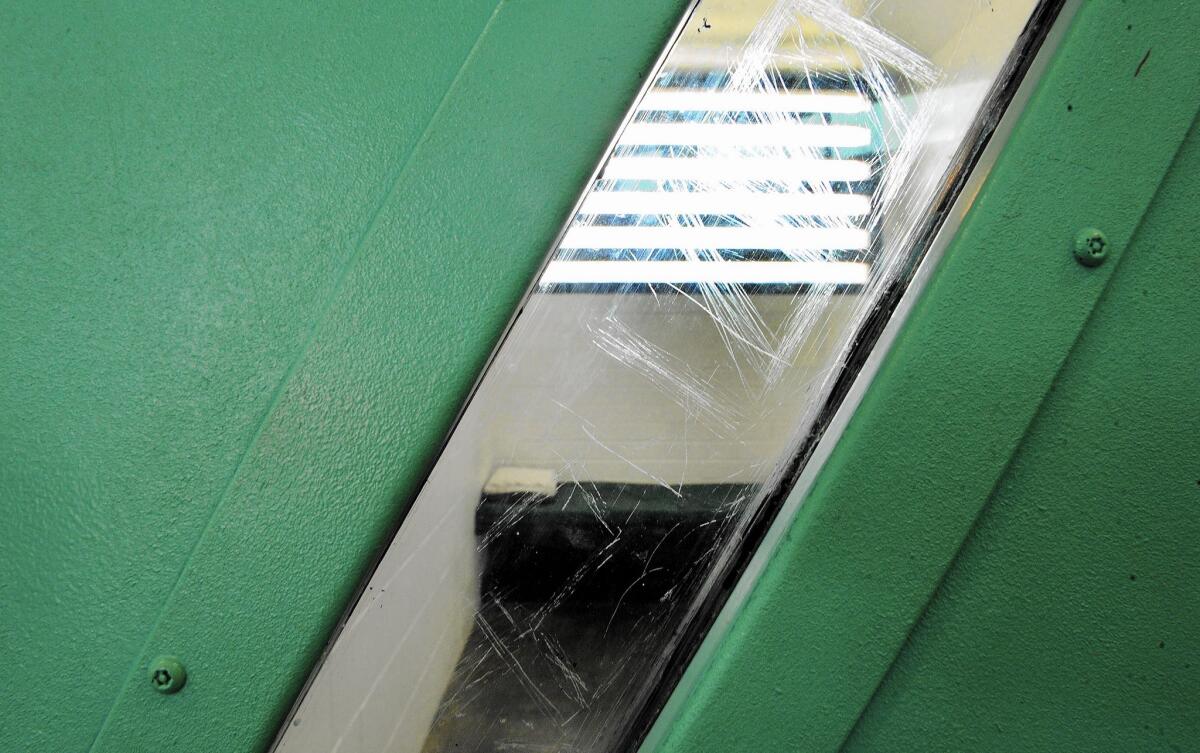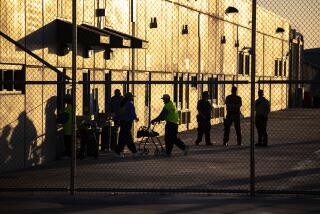State prisons are relying less on solitary confinement as punishment

An empty solitary confinement cell at the Barry J. Nidorf Juvenile Hall in Sylmar.
- Share via
Reporting from Sacramento — Even as it prepares for a courtroom showdown over the use of prolonged solitary confinement to keep order in its prisons, California has adopted emergency rules to dial down such isolation.
Inmates may no longer be put in isolation for refusing a cell assignment, for example, one of several prison infractions for which solitary confinement punishment has been reduced or dropped. And those being disciplined with segregation can cut that punishment in half with good behavior.
“This is part of an ongoing evolution in how we manage inmates in segregation,” said Terry Thornton, a spokeswoman for the corrections department. “There will be more changes.”
The new rules went into effect last month, ahead of public hearings scheduled for August. They come atop other changes that have cut the count of California prisoners held in near-constant lockdown from more than 9,800 in early 2014 to just under 8,700 last month.
The revisions also have been made amid an escalating debate over solitary confinement in U.S. prisons, of which California has the largest share.
Advocates for inmates are preparing to release research by a prominent corrections psychiatrist describing a malady he calls “SHU Post-Release Syndrome,” a reference to the Security Housing Unit, California’s name for long-term solitary confinement.
The study documents some of the same psychiatric effects raised last month by U.S. Supreme Court Justice Anthony Kennedy in an unusual opinion in a California death penalty case. He essentially invited a constitutional challenge to long-term isolation and the “terrible price” it extracts.
At a congressional budget hearing this year, Kennedy opined that “solitary confinement literally drives men mad.... We simply have to look at this system that we have.”
The jurist’s remarks came as California entered settlement negotiations with lawyers from the Center for Constitutional Rights, representing prisoners who have sued the state over its practice of holding inmates accused of gang ties in solitary confinement indefinitely.
Their lawsuit alleges that the resulting sensory deprivation causes psychological and physical torment.
Court dockets show that recently, state corrections Secretary Jeffrey Beard personally joined the talks, for which a federal judge has set a Thursday deadline. Neither side would comment, beyond an optimism expressed by the inmates’ lawyers that Beard’s involvement signals an impending deal.
In a study prepared for a trial set for December on the constitutionality of decades-long solitary confinement, psychiatrist Terry Kupers said damage persists long after an inmate is freed from isolation.
Kupers said he found common symptoms in nearly two dozen men who had spent years in isolation at California’s maximum-security Pelican Bay State Prison. Even after they were freed, his report said, the men essentially re-created the experience of being locked in a small area.
They withdrew into small spaces and isolated themselves except for a few known contacts. They experienced anxiety in new situations and around unfamiliar people.
For some, symptoms faded within months of release from solitary. For others, Kupers said, it appeared a permanent condition. He said the problems were greatest for those paroled from solitary directly to the streets.
“They come out, they are broken,” he said this week in an interview.
Lawyers for state Atty. Gen. Kamala D. Harris have defended the use of lengthy solitary confinement at four super-maximum security prisons in California. In court filings, they said they were surprised by Kupers’ “theory” and argued for time to have their own psychiatrists evaluate his research subjects.
Officials say the isolation wings at the four prisons are necessary to confine gangs that command violent statewide networks, running drugs and ordering killings in and outside of the lockups.
In June, federal prosecutors alleged that three rival Los Angeles narcotics gangs were united and controlled by a Mexican Mafia leader operating within solitary confinement at Pelican Bay.
Inmates in these units are kept in cells 23 hours a day, most without a cellmate and with little human contact beyond the guards who deliver food. There is little natural light, doors open and close by remote switch and inmates contend their sleep is often interrupted by hourly suicide checks.
Prison policies restrict access to phones, mailed packages and food canteens, and for some inmates visits with family transpire across a thick sheet of glass.
Court transcripts show that inmates’ lawyers have pressed for California to offer counseling to prisoners as they are released from solitary confinement, a punishment state officials say they do not employ.
“There is no ‘solitary confinement’ in California,” the corrections agency stated in a regulatory filing last month.
Some states — including Colorado, where a prisoner paroled from solitary assassinated the state prisons chief two years ago — now require a six-month transition program before release.
California began reducing its use of solitary confinement In late 2012.
Officials began reviewing the files of the thousands of inmates in solitary confinement and allowing those in indefinite isolation to work their way out. By January 2013, more than half of those first reviewed did not meet the new standard for seclusion and were moved.
Last year, those reviews included the Pelican Bay inmates bringing the class-action suit. All but two of the plaintiffs were reclassified.
Those moved out of solitary included Gabriel Reyes, who had been kept in segregation more than 14 years for possession of tattoo artwork containing Aztec symbolism tied to the Mexican Mafia.
Reyes has since been moved to the general prison population. But his lawyers say he remains locked in his new cell about 23 hours a day.
California also has created “non-disciplinary segregation,” with extra privileges for those put into isolation for their own protection, and “short-term restricted housing” that doubled the time mentally ill prisoners may spend outside their cells to 20 hours from 10.
Beard last year described the new programs as part of “lasting cultural changes.” Thornton said this month that as a result, isolation cells in seven prisons have been converted to other uses.
In June 2014, when U.S. District Judge Claudia Wilken granted class-action status to the solitary confinement case, more than 500 prisoners had been held in isolation at Pelican Bay more than 10 years.
As of last month, lawyers said, that number was about 80.
Twitter: @paigeastjohn
More to Read
Sign up for Essential California
The most important California stories and recommendations in your inbox every morning.
You may occasionally receive promotional content from the Los Angeles Times.














